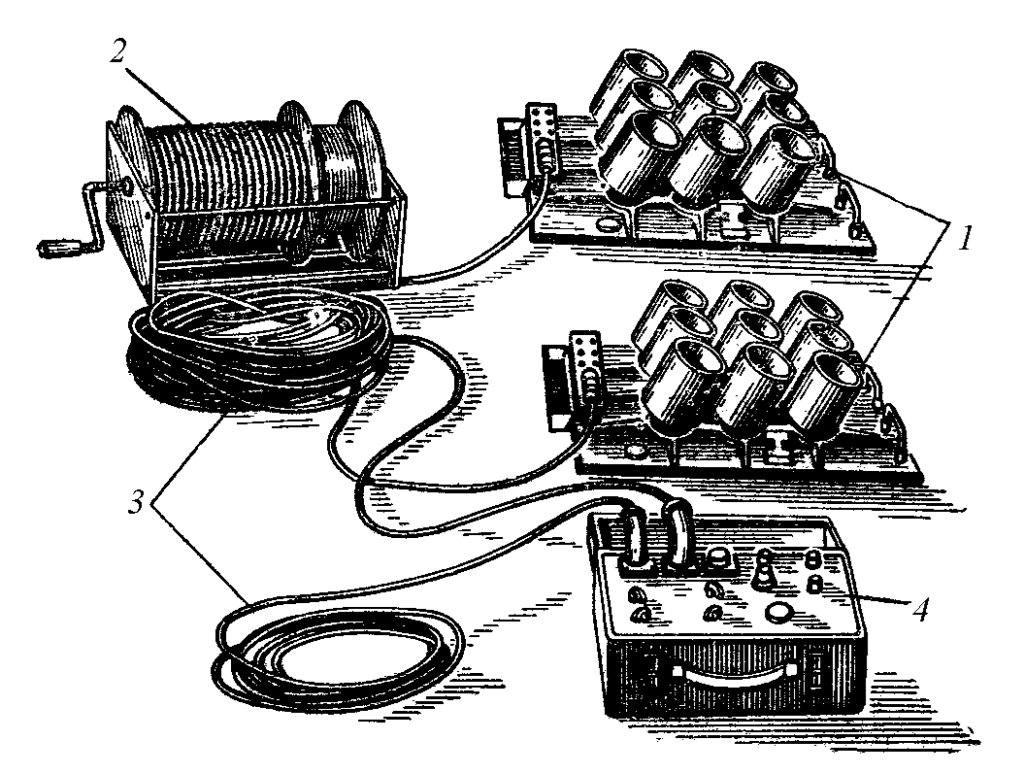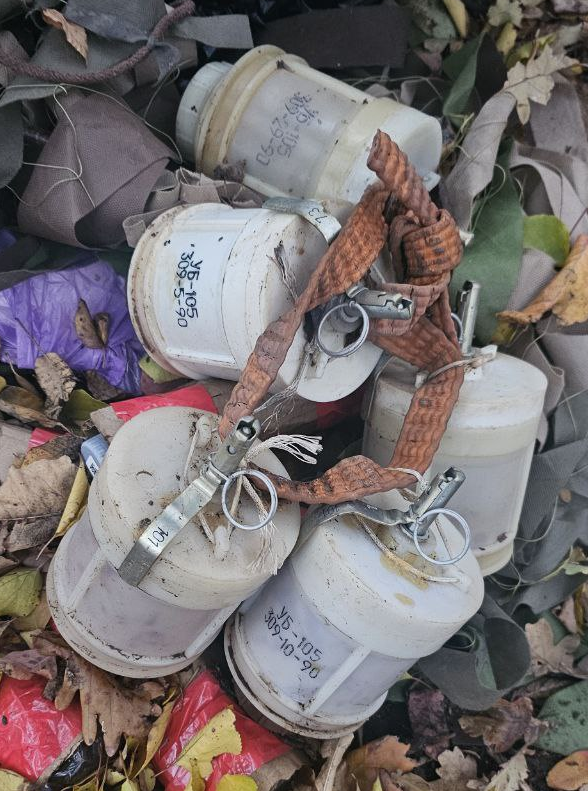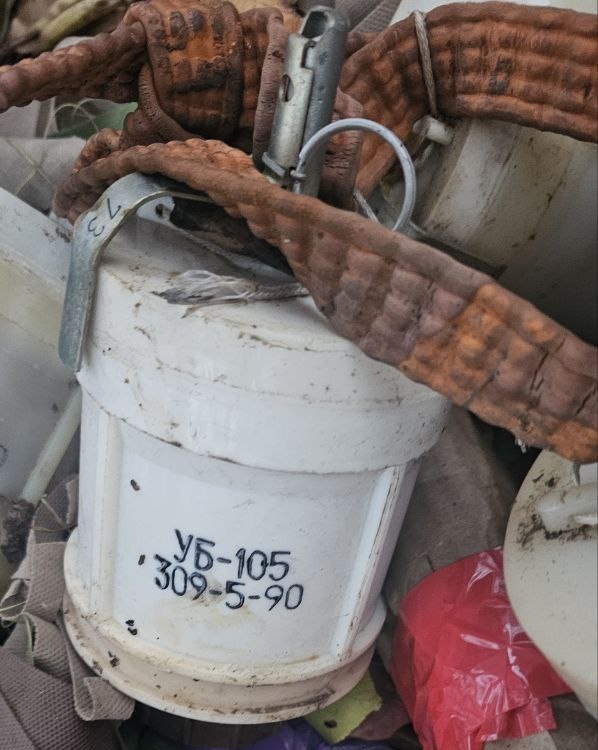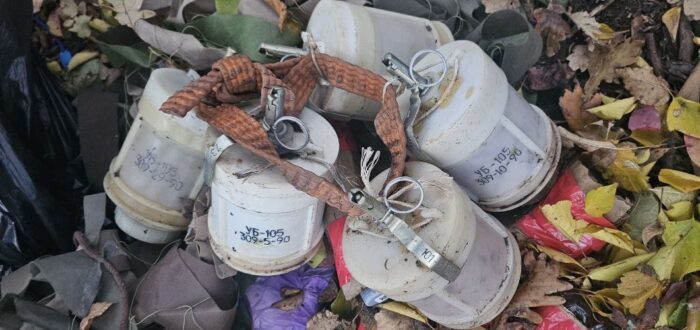Patrick Senft
Since the full-scale invasion of Ukraine in 2022, munitions containing chemical payloads have frequently been documented on the battlefields of that country. Most of these weapons are hand-grenade-type munitions delivering an irritant agent—i.e., a payload generally regarded as less-lethal. Such munitions have generally been used to dislodge enemy forces from entrenched fighting positions, and are often deployed via unmanned aerial vehicles (UAVs). However, a different type of chemical munition has recently been documented in Ukraine—the UB-105 (‘УБ-105’) chemical warfare agent imitator. The UB-105 is designed to train soldiers to operate under conditions that mimic exposure to the nerve agent VX. The munition contains a liquid compound that simulates the presence of the VX warfare agent when dispersed. The UB-105’s chemical payload, referred to as URFOV-2 (‘УРФОВ-2’), comprises a mixture of tributyl phosphate, triethanolamine, and the decomposition and interaction products of these compounds. Additionally, technical documentation for the UB-105 frequently suggests users add other agents—such as chloropicrin—to the munition in order to modify the training environment.
The URFOV-2 agent contaminates uniforms and equipment in a similar fashion to VX, and can even trigger some chemical warfare detection equipment intended to register VX. The indicator film AP-1, for example, reportedly reacts identically to VX and URFOV-2 exposure, whereas indicator tubes IT-44 and IT-51 do not detect URFOV-2. Although the training agent is generally described as non-lethal, it exhibits some toxic effects as it can cause skin burns upon direct contact. In addition, URFOV-2 is described as emitting a pungent odour reminiscent of rotting fish.
The UB-105 is part of the UKOV-1 (‘УКОВ-1’) kit, a system designed to simulate chemical warfare conditions. This kit (see Figure 1, below) consists of two electrically initiated launchers with nine barrels each, a control panel, cables, and spare parts. Car batteries can serve as an alternative power source in the absence of standard equipment. When all 18 barrels are fired, the URFOV-2 agent can contaminate an area of up to 20,000 m² with concentrations high enough to simulate VX contamination.

The UB-105 munition itself is relatively simple in design. It features an electrically initiated expulsion charge in the base, which propels the munition from the launcher, and a delayed bursting charge that disperses the chemical agent at altitudes ranging between 10 and 90 meters and at distances of around 80 m.

The presence of UB-105 munitions in Ukraine was first highlighted in a report by the Counterintelligence Department of the Security Service of Ukraine. This report was submitted as part of the Statement by the Delegation of Ukraine during the 106th session of the Executive Council of the OPCW in July 2024. The Counterintelligence Department stated that Russian forces had begun deploying UB-105 munitions on the front lines in the Donetsk region. Images included in the report showed fragments of what appeared to be a functioned UB-105 munition. However, the images alone provided limited information on the munition’s method of employment.
Further insights were made possible by more recently obtained images shared on a closed Telegram channel used by Russian sappers on7 November 2024. These images show six UB-105 canisters modified with UZRG-type fuzes, originally intended for hand grenades such as the Russian F1 model.

The UB-105 munitions in these images appear to have had their expulsion charge compartment and rubber sealant ring removed. Fitting the UB-105 canister with the fuze from a hand grenade appears to make use of the filling hole in the top of the munition. By having the fuze inserted into the top of the container, rather than the bottom, the resultant munition does not make use of the bursting charge typically installed in the UB-105. Thus, when the UZRG-type fuze functions, the URFOV-2 agent is dispersed solely by the relatively small charge in the fuze.

As noted, the URFOV-2 agent is not in itself lethal. However, the Ukrainian Counterintelligence Department points out that it is not clear whether the original agent in the UB-105 may have been augmented with irritants (a method suggested in Russian technical manuals to enhance the training experience) or even lethal compounds (a possibility that introduces ambiguity and uncertainty into any use case). This is a speculative, but plausible, scenario, and the escalatory potential of this development cannot be underestimated.
The UB-105 munition, while non-lethal, is specifically designed to mimic the physical and chemical properties of the highly lethal VX nerve agent. This mimicry not only increases the likelihood of confusion on the battlefield but may also lead to erroneous reports from detection equipment, which may register the presence of VX. The possibility of a false-positive detection of VX on the battlefield has the potential to impede investigations by international organisations by generating confusion, causing delays, requiring repeated sampling, and diverting resources from critical verification activities. Furthermore, the psychological impact on troops and civilians who believe they are under a chemical attack—even if the agent is non-lethal—can create chaos, undermine morale, and escalate demands for more aggressive responses from political and military leaders.
Special thanks to Trevor Ball, Tony Salvo, and N.R. Jenzen-Jones for their invaluable assistance with this piece.

Sources
ARES (Armament Research Services). n.d. Conflict Materiel (CONMAT) Database. Confidential. Perth: ARES.
Alimov, N. I., V. V. Gormay, & Gracheva, M. E. N.d. Способ утилизации учебной рецептуры УРФОВ-2 [‘Method for Disposal of the Educational Formulation of URFOV-2’]. Patent No. 2122876. Military Unit 61469 of the Russian Armed Forces. Saratov Oblast. <https://poleznayamodel.ru/patent/212/2122876.html>.
Basic Concepts of Military Service Security. 2012. Требования безопасности военнослужащих при проведении занятий по физической подготовке [‘Safety requirements for military personnel during physical training classes]’. Rostov-on-Don: Russian Military Training Centre.
Bukhtoyarov, V.I. 1988. Учебник Сержанта Химических Войск [‘Chemical Troops Sergeant’s Manual’]. Moscow: Ministry of Defence of the USSR, Department of the Chief of Chemical Troops.
Ministry of Defence of Ukraine. 2004. Посібник сержанта військ радіаційного, хімічного та біологічного захисту [‘Sergeant’s Guide to Radiation, Chemical, and Biological Protection’]. Kharkiv Guards Order of the Red Star Tank.
Permanent Representation of Ukraine to the OPCW. 2024. ‘Statement by the Delegation of Ukraine at the 105th session of the Executive Council’. 6 March 2024. <https://www.opcw.org/sites/default/files/documents/2024/03/Ukraine%20-%20Statement%20by%20the%20Delegation%20of%20Ukraine%20to%20the%20OPCW%20at%20the%20105th%20Session%20of%20the%20Executive%20Council%20under%20Agenda%20Item%207%28e%29.pdf>.
Permanent Representation of Ukraine to the OPCW. 2024. ‘Statement by the Delegation of Ukraine at the 106th session of the Executive Council’. 11 July 2024. <https://www.opcw.org/sites/default/files/documents/2024/07/Ukraine_Statement_Agenda_item_6e_rev_pdf.pdf>.
Sazonov, I., A. Smirnov & Y. Basharin. 2021. ‘Army Collection Vol. 11.’ November 2021. Federal State Budgetary Institution “RIC Red Star” of the Ministry of Defense of Russia. Pages 71–74.
Remember, all arms and munitions are dangerous. Treat all firearms as if they are loaded, and all munitions as if they are live, until you have personally confirmed otherwise. If you do not have specialist knowledge, never assume that arms or munitions are safe to handle until they have been inspected by a subject matter specialist. You should not approach, handle, move, operate, or modify arms and munitions unless explicitly trained to do so. If you encounter any unexploded ordnance (UXO) or explosive remnants of war (ERW), always remember the ‘ARMS’ acronym:
AVOID the area
RECORD all relevant information
MARK the area from a safe distance to warn others
SEEK assistance from the relevant authorities

